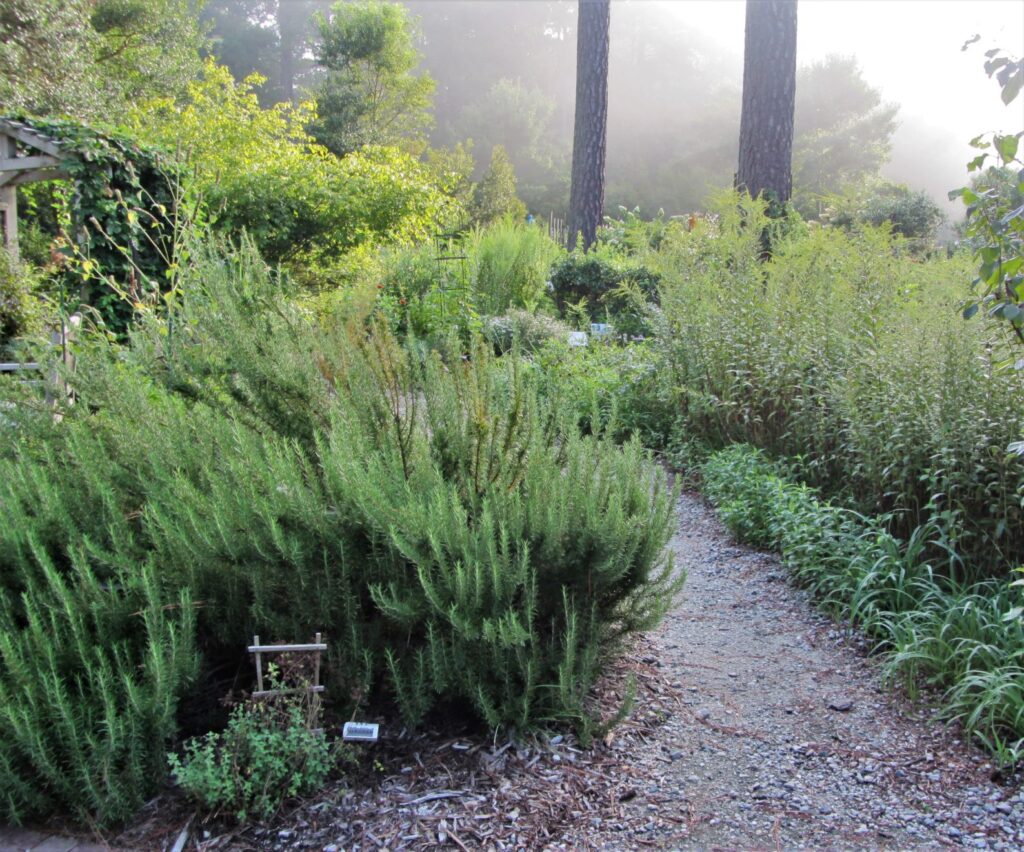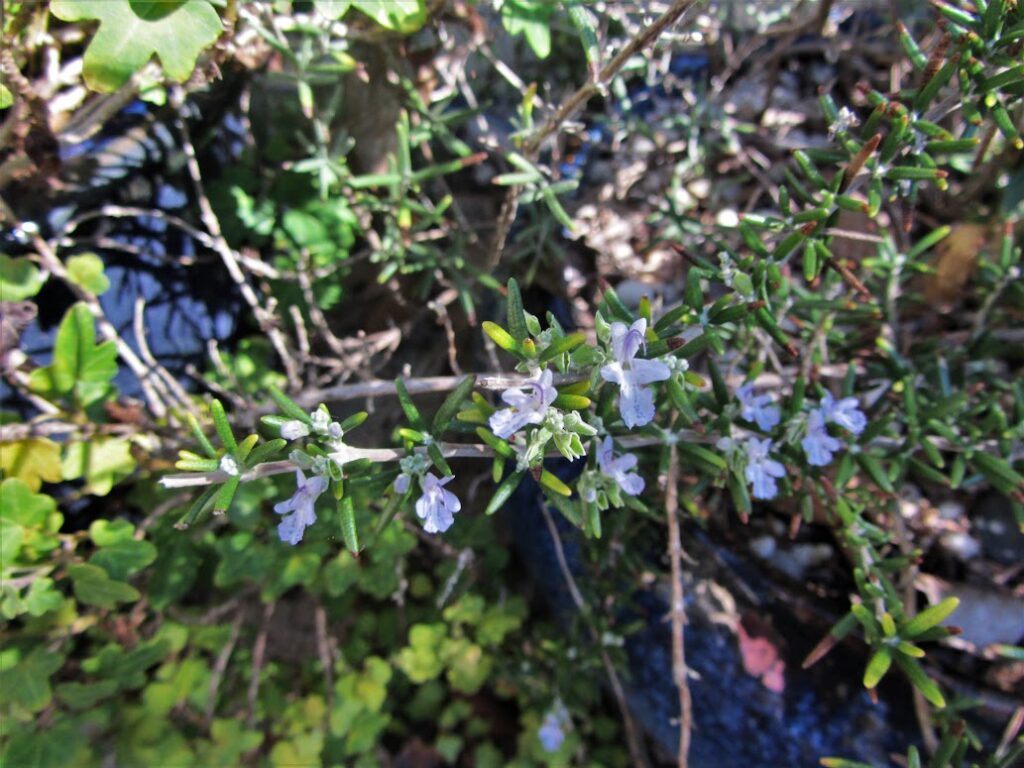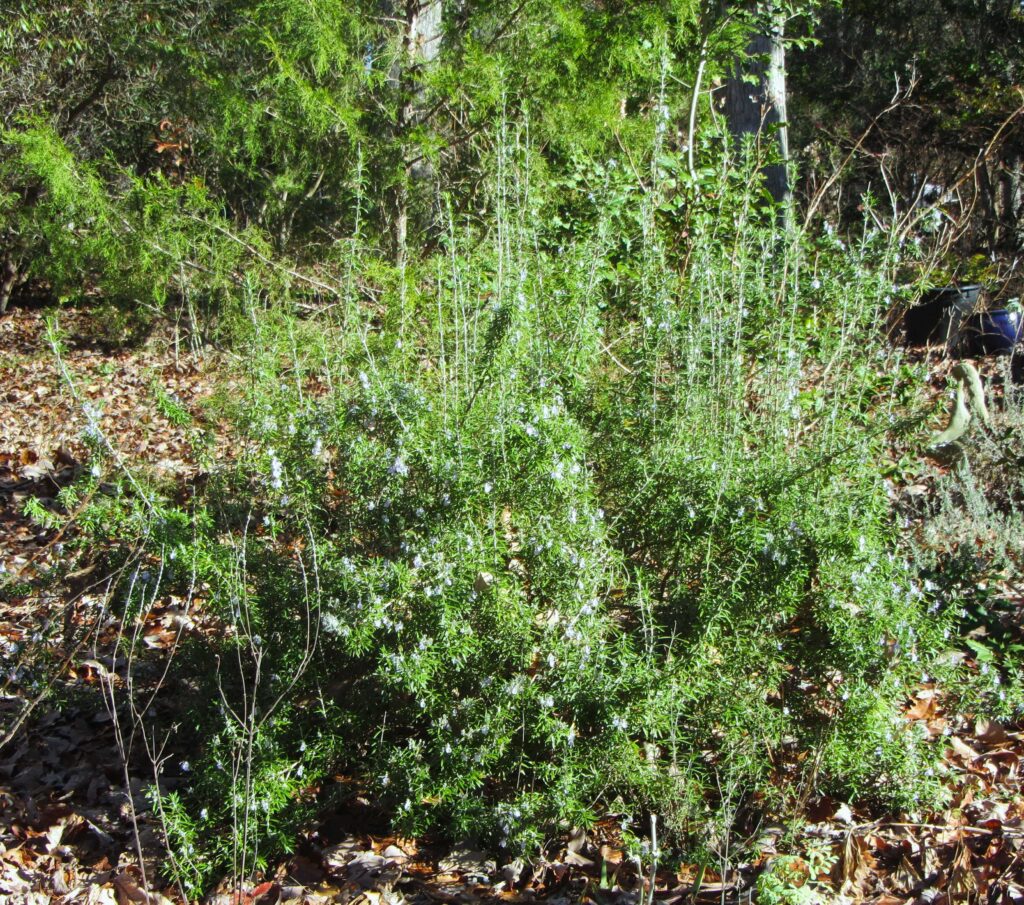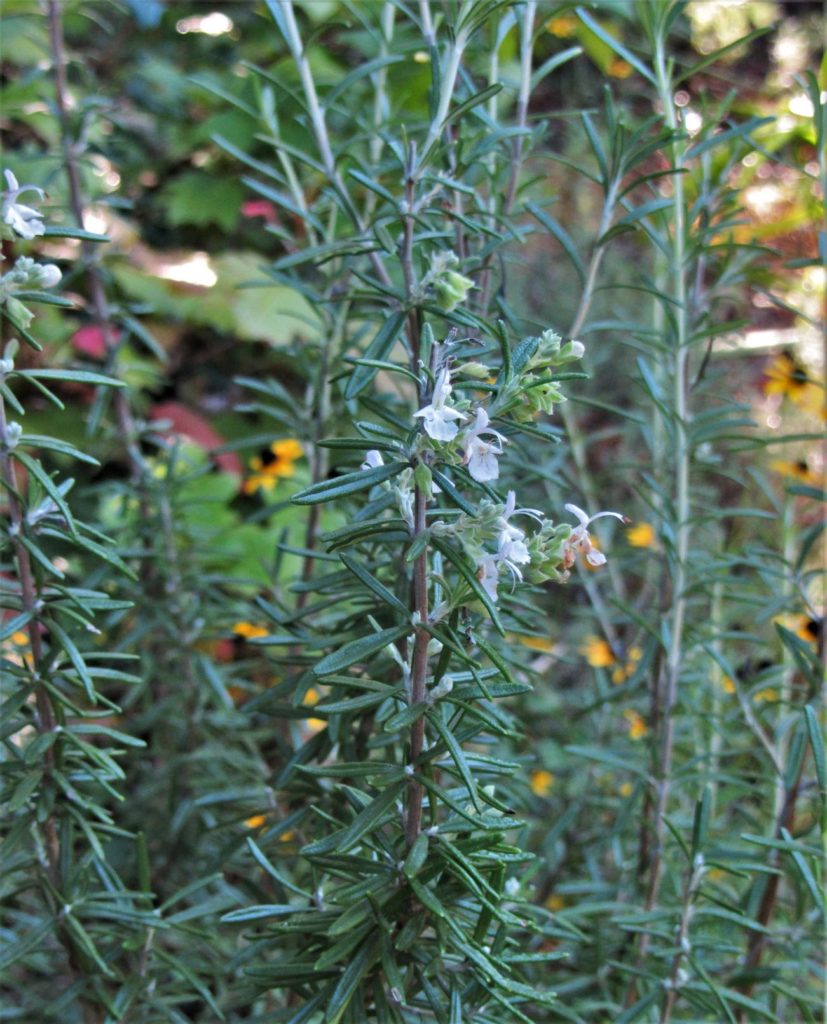Mythical Rosemary
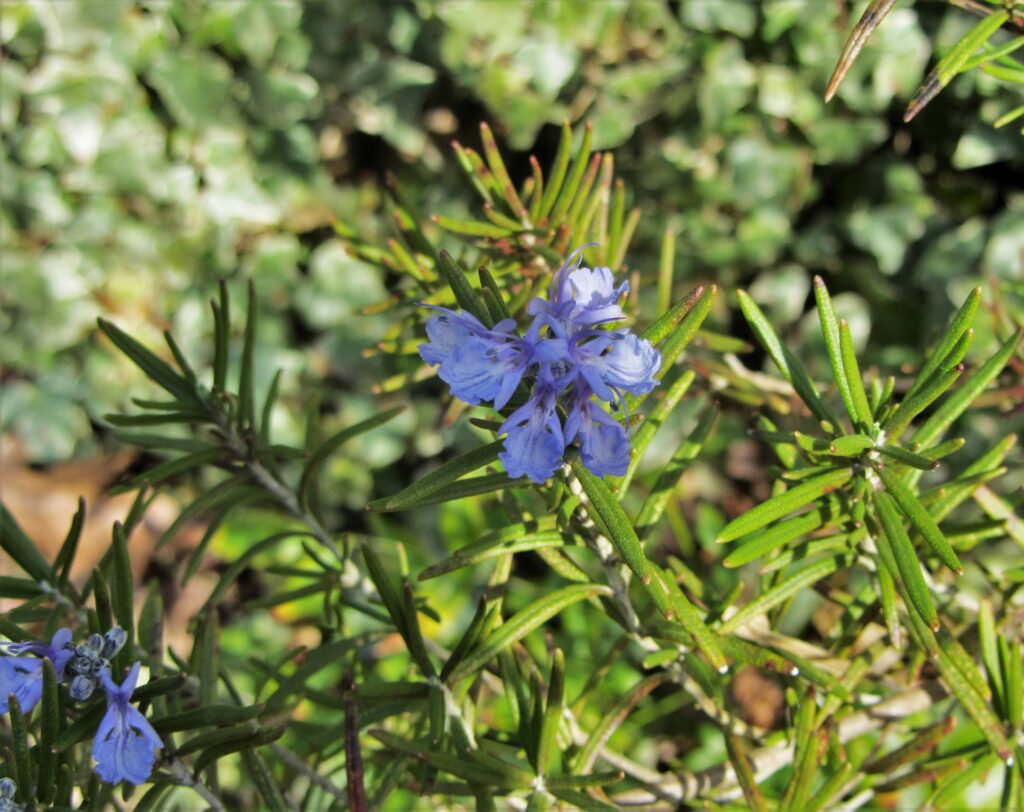
Salvia rosmarinus blooming in late winter
Mythical Rosemary
The woody, green fragrance of rosemary brings happiness. Rosemary has served as food, fragrance, medicine, as a religious tool, and as a favorite garden plant for millennia. It is considered a sacred and magical herb, associated both with Aphrodite and with Mother Mary. Rosemary has been planted in monastery, temple, medicinal and royal gardens over many centuries.
Known now as Salvia Rosmarinus, rather than the Rosmarinus officinalis we all learned, rosemary has one of the longest cultural and botanical history of any plant in the garden. Rosemary is valued for its evergreen growth, its flowers, its essential oil, and its medicinal properties. Now considered a species of Salvia, it is a member of the Lamiaceae family of mints and other herbs. Close to thirty named cultivars of rosemary are currently available.
Rosemary in Ancient Gardens
When cuneiform tablets left by the ancient Sumerians were translated, archeologists found mention of rosemary from more than 7000 years ago. The Egyptians, Greeks, Romans, Babylonians, and many other Western cultures have used rosemary throughout recorded history. It has symbolized love, remembrance, faithfulness, clarity of thought, and sincerity across the centuries.
An Herb of Protection and Remembrance
Tradition tells us that rosemary is a protective herb and so is often planted by gateways and doorways to keep evil away from one’s home. It can help to attract good relationships and protect existing ones. Rosemary traditionally was burned as a ‘smudge’ to cleanse a home after a death from illness. It is one of the traditional herbs believed to attract fairies to help tend a garden.
Cooking With Rosemary
Herbalists, chefs, beekeepers, and gardeners all prize Rosemary. Its distinctive fragrance and flavor are incomparable, and it is an antioxidant. Use rosemary fresh or dried in cooking roasts, soups, and stews. Sizzle a few leaves in oil to flavor it before adding vegetables or meat to the pan. Add fresh rosemary leaves to flavor oils, vinegar, honey, or butter. Skewer meat and vegetables on rosemary stems before grilling. Mix dried and crumbled leaves with coarse salt, and other herbs, to make a rub for meats.
Brew rosemary leaves in hot water alone or with other herbs for tea. Rosemary leaves may be added to wine and spirits, particularly at the holidays.
The Fragrance of Rosemary
Rosemary sprigs were burned as incense in ancient temples, especially in Egypt. It is one of the oldest types of incense. Add dried rosemary flowers and leaves, or the essential oil, to potpourri for long-lasting fragrance. Lay sprigs of dried rosemary in drawers to keep clothing fresh and to repel moths.
Fresh springs of rosemary may be used in wreaths, flower arrangements, and added to corsages. Rosemary is an appropriate herb to add to Christmas and Winter Solstice wreathes, garlands, and displays of evergreens because it smells wonderful and it reminds us of everlasting life.
Branches of rosemary were once included in floral ‘crowns’ for brides, to symbolize remembrance and faithfulness in their marriage. There is also a long tradition of wearing or carrying rosemary to funerals and memorial services. The rosemary is tossed into the grave, symbolizing love for the deceased and the promise of eternal life, just before the grave is filled.
Rosemary, and its essential oil, can lift depression and improve memory. It can relieve pain, particularly headaches. Students in ancient Greece wore sprigs of rosemary to help them remember their lessons. Rosemary oil is anti-microbial and anti-inflammatory, and is a common ingredient in soaps, shampoos, perfumes, lotions, and even in some cleaning products.
Rosemary for Sustainable Gardens
A Mediterranean herb, rosemary is native to the dry, rocky regions of Southern Europe, the Middle East, Northern Africa near the Mediterranean Sea, and in Western Asia. Like other useful herbs, it has spread world-wide wherever conditions permit it to grow. Early colonists brought rosemary to North American in the 17th century and it became popular in Colonial American herb gardens. Find rosemary in several gardens at Colonial Williamsburg today.
While some varieties aren’t frost tolerant, several prove hardy to at least Zone 6. Once established, rosemary tolerates both heat and drought. It blooms and performs best in full sun but will grow in partial shade. All varieties of rosemary require good drainage and will decline in consistently wet soil. Rosemary grows well in sandy soil and is salt tolerant, and so is a good choice for seaside gardens.
Plant rosemary in full sun where it has space to develop into its full potential. It prefers light, neutral to slightly acidic soil. If planting into heavy clay soil, incorporate some compost, and possibly some sand or pea gravel in a hole at least twice as wide as the root ball. Gravel mulch reflects heat and light into the center of the plant, and it promotes good health by keeping the lower branches clean. It can also help insulate the roots during the coldest weeks in winter.
Rosemary in the Garden
Rosemary matures into a medium sized woody, evergreen shrub. It develops a woody trunk and roots. Cold hardy varieties like ‘Arp’ may grow 4’-6’ high and wide over time. A healthy rosemary may live 20 to 30 years, and becomes a permanent structural fixture in the garden, like other non-edible evergreen shrubs.
Plant rosemary as a focal point, space plants 2’-4’ apart for hedges, incorporate them in four-season outdoor pots, or use them in a dedicated herb or kitchen garden. Rosemary will grow well in a pot with spring bulbs, Violas, and other annual or perennial herbaceous plants. As other plants come and go, the rosemary will anchor an outdoor arrangement throughout the year. Rosemary plants require direct sunlight near a window or on a sun porch to prosper indoors. After a year or two, they should be planted out into the garden, or into a larger pot or tub to allow them to develop.
Essential oils that make rosemary useful and delicious also protect it from grazers. Deer, rabbits, and other animals avoid it. Its fragrance repels them. Rosemary is largely disease and pest free when given sunlight and good drainage.
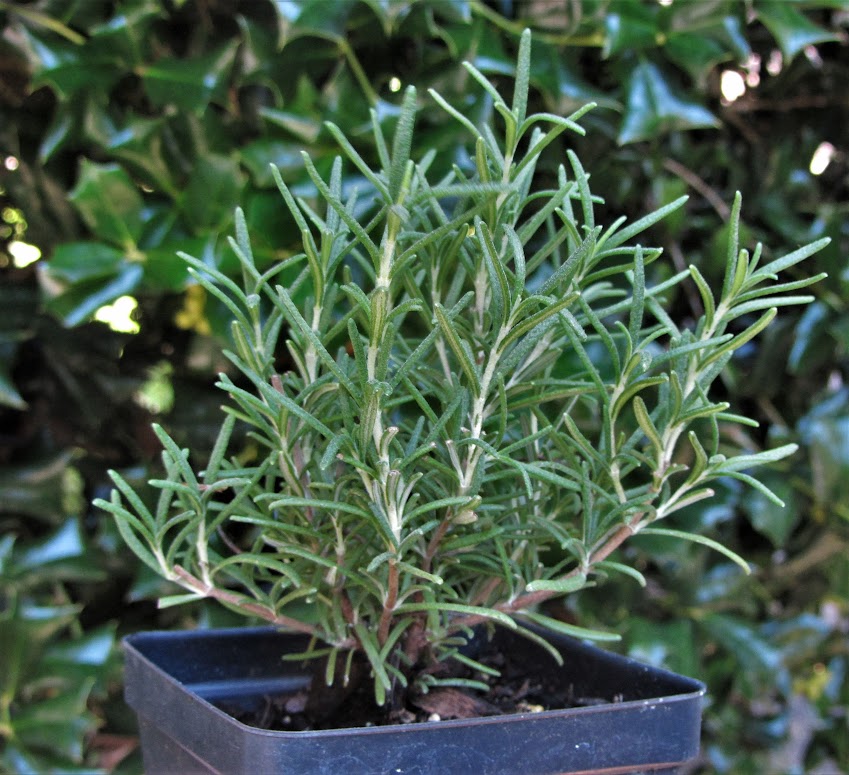
Buy starts of named cultivars of rosemary at garden centers and some grocery stores. It is very slow to grow from seeds.
Special Types of Rosemary
Rosemary topiaries come to market around the holidays. Rosemary responds well to frequent clipping and may be trained in formal shapes. Cut young shrubs back after blooming to encourage bushy growth. Older shrubs may need pruning to open them up to improve air circulation. Use the prunings fresh or dried for various purposes.
Grow ‘Prostratus,’ or creeping rosemary, along the top edges of walls, in hanging baskets or tall pots, or as ground cover. Rather than growing up into a shrub form, its long branches grow sideways and cascade downwards. It will grow to 1’-2’ tall but will cascade 3’-4’ below its crown, where space allows. Hardy to Zone 8, ‘Prostratus’ it will thrive through our Williamsburg winters, especially when mulched and given a sheltered location. There are other named cultivars with a similar habit, such as ‘Irene,’ valued for their exceptional flowers.
Another interesting cultivar rated to Zone 8 is ‘Barbecue.’ Its strong, straight stems are excellent skewers for foods cooked on the grill. ‘Tuscan Blue,’ also rated to Zone 8, has attractive blue flowers and grows to about 6’. It grows well in our area and is frequently offered at local businesses. Cultivars with golden and with variegated leaves can be harder to source.

Some varieties of rosemary may grow to 6′ tall if not regularly trimmed. Use rosemary like an evergreen, woody shrub. It is a great companion plant in the perennial garden.
Propagation
Propagate rosemary from stem cuttings in sterile potting soil or vermiculite. Cover the container with a clear plastic bag or dome to hold moisture while the cuttings root. It responds well to layering. It isn’t a good candidate for division and grows slowly from seed. Find plants throughout most of the year at nurseries that sell herbs and in some grocery stores.
Plant Rosemary to Support Pollinators
Rosemary flowers support many pollinators. Though small, they offer abundant nectar. Excellent honey is produced by bees with access to rosemary shrubs. Rosemary often blooms in the summer and then again during the cold season, in our garden, offering nectar when little else is available. Find cultivars with flowers in various shades of white, pink, blue, and lavender.
Rosemary remains vibrantly green and blooms even in the winter. It is a timeless classic. Easy to grow, it proves an endlessly useful plant for gardeners. And it smells like happiness.
All photos by Elizabeth McCoy, Master Gardener Tree Steward.
For More Information:
Dutton, Joan Parry. Plants of Colonial Williamsburg – How to Identify 200 of Colonial America’s Flowers, Herbs and Trees. The Colonial Williamsburg Foundation. 1979.
Grieve, Mrs. M. A Modern Herbal in Two Volumes, Volume II I-Z. Harcourt, Brace, & Company. 1931.
Keville, Kathi, and Jeffrey Laign. Complete Book of Herbs, Using Herbs to Enrich Your Garden Home, and Health. Publications International, Ltd. 1997.
Halpin, Anne M. editor. Rodale’s Home Gardening Library Herbs. Rodale Press. 1988.
Hopkinson, Patricia, Diane Miske, Jerry Parsons, Holly Shimizu, and Kathy Sammis. Herb Gardening. Pantheon Books, Knopf Publishing Group. 1994.
Ogden, Shepherd and Ellen Ogden. The Cook’s Garden, Growing and Using the Best-Tasting Vegetable Varieties. Rodale Press. 1989.
Rago, Linda Ours. Dooryard Herbs. Carabelle Books. 1984.

